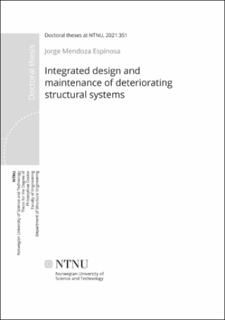| dc.contributor.advisor | Köhler, Jochen | |
| dc.contributor.advisor | Muskulus, Michael | |
| dc.contributor.author | Espinosa, Jorge Mendoza | |
| dc.date.accessioned | 2021-11-10T06:59:35Z | |
| dc.date.available | 2021-11-10T06:59:35Z | |
| dc.date.issued | 2021 | |
| dc.identifier.isbn | 978-82-326-6954-7 | |
| dc.identifier.issn | 2703-8084 | |
| dc.identifier.uri | https://hdl.handle.net/11250/2828796 | |
| dc.description.abstract | Large structural systems such as bridges and offshore structures are subject to deterioration processes during their service life. Specifically, fatigue and corrosion are of major concern. To ensure that the structures are operated within acceptable safety levels, actions to mitigate the risks associated with deterioration need to be conducted throughout their life cycle. Examples of mitigation actions are to increase the reliability of the deterioration-sensitive components at design (e.g., by increasing their resisting cross-section area), to choose more robust structural configurations to minimise the consequences of deterioration, and to repair structural components based on identified damage. Generally, the optimal mitigation strategy will be a combination of several mitigation measures. The limited societal budgets and the increasing environmental concerns demand an efficient use of the construction materials. To efficiently manage the large portfolios of existing and planned infrastructure systems, the decisions made throughout the life cycle of the structures need to be optimised within a common framework.
The aim of this thesis is to improve the design basis of mitigation strategies for structural systems. Structural reliability methods are used to assess the effect of the mitigation measures on structural safety. At the design phase, the effect of future inspections and monitoring on the system reliability can be estimated by integrating over possible outcomes using prior information. Similarly, one can perform the same integration at any stage of the service life based on information updated with obtained data. Reliability- and risk-based design are applied to the assessment of the optimal mitigation strategies at the system level. System-level design is of particular relevance for the present research, because aspects such as spatial dependence of the deterioration processes or structural redundancy have a strong effect on the system reliability and the value of the information that can be obtained.
A framework for simultaneously assessing optimal design and inspection strategies is developed. This framework is then applied to the investigation of how the optimal mitigation strategy varies as a function of system redundancy and size. These results aim at generalising decision rules for the standardisation of mitigation strategies. Moreover, a novel method for assessing system reliability bounds of multimember offshore structures subject to extreme environmental loads and high-cycle fatigue is developed. This method is applied to the assessment of the reliability associated with existing system-level design methodologies and the evaluation of system effects, such as fatigue dependence and progressive collapse. In addition to the developed theoretical frameworks, the articles include several examples of applications, specifically on the design of monopile support structures for offshore wind turbines subject to fatigue and extreme environmental loads, and on the design, reassessment and inspection planning of mooring systems affected by combined fatigue and pitting corrosion. | en_US |
| dc.language.iso | eng | en_US |
| dc.publisher | NTNU | en_US |
| dc.relation.ispartofseries | Doctoral theses at NTNU;2021:351 | |
| dc.relation.haspart | Paper 1: Mendoza Espinosa, Jorge; Bismut, Elizabeth; Straub, Daniel; Kohler, Jochen. Risk-based Fatigue Design Considering Inspections and Maintenance. ASCE-ASME Journal of Risk and Uncertainty in Engineering Systems. Part A: Civil Engineering 2021 ;Volum 7.(1) https://doi.org/10.1061/AJRUA6.0001104 | en_US |
| dc.relation.haspart | Paper 2: Mendoza, J., E. Bismut, D. Straub, and J. K¨ohler. Optimal life-cycle mitigation of fatigue failure risk for structural systems. | en_US |
| dc.relation.haspart | Paper 3: Mendoza, J., J.S. Nielsen, J.D. Sørensen, and J. Köhler. Structural reliability analysis of offshore jackets for systemlevel fatigue design. | en_US |
| dc.relation.haspart | Paper 4: Mendoza Espinosa, Jorge; Haagensen, Per Jahn; Kohler, Jochen. Analysis of fatigue test data of retrieved mooring chain links subject to pitting corrosion. Marine Structures 2021
https://doi.org/10.1016/j.marstruc.2021.103119
This is an open access article under the CC BY-NC-ND license | en_US |
| dc.relation.haspart | Paper 5: Mendoza Espinosa, Jorge; Paglia, Jacopo; Eidsvik, Jo; Kohler, Jochen. Value of information of in-situ inspections of mooring lines. Proceedings of the Institution of Mechanical Engineers. Part O, Journal of risk and reliability 2021
https://doi.org/10.1177/1748006X20987404 | en_US |
| dc.relation.haspart | Paper 6: Mendoza Espinosa, Jorge; Kohler, Jochen. Risk-based Design of an Offshore Wind Turbine using VoI Analysis. I: 13th International Conference on Applications of Statistics and Probability in Civil Engineering (ICASP13). s. 1-8
https://doi.org/10.22725/ICASP13.300 | en_US |
| dc.title | Integrated design and maintenance of deteriorating structural systems | en_US |
| dc.type | Doctoral thesis | en_US |
| dc.subject.nsi | VDP::Technology: 500::Materials science and engineering: 520::Building materials: 525 | en_US |

